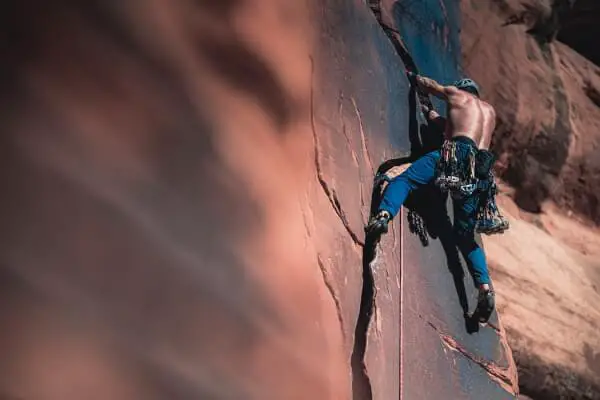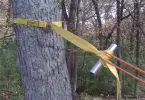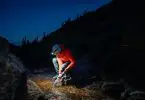In recent years, rock climbing has transformed into one of the most popular physical activities in the world. There are many reasons for this, but the great news is that rock climbing is fun and easy for people of any skill or comfort level.
One important thing beginners should keep in mind is that they don’t need to feel intimidated, it’s easy to get discouraged but the best way to improve is to keep trying.
Rock climbing is equal parts mental, physical, and technical. The technique behind pushing your body up the rock does not come easily to most people.
See also: Rock Climbing Knots: A Sure Way to Safe Climbing
Yet most climbers only focus on the physical. Being good at rock climbing is all about learning proper technique and ingraining movements, coordinating the lower and upper body, and maintaining awareness of how much work you have done to the point that it becomes your nature.
In the long run, good technique will take you much further but yet most climbers still focus on trying to get stronger, most times at the expense of learning good technique. Training with the aim of improving your technique requires a certain degree of consciousness about what you’re doing. Climbers who train will see big improvements in fitness.
Knowing a few basic techniques will help you achieve the balance, range of motion and stamina required for basic climbing. Also, check out our review of the best climbing ropes for more options.
How to Rock Climb for Novice Climbers
Rock climbing is a diverse sport with variations which involve climbing from the bottom to the top of a piece of rock without falling. If you always wanted to go climbing but don’t know where to start, below are some basic guide to climbing styles and techniques for beginners.
Warm up and stretch
Taking time to warm up and stretch your muscles to improve flexibility and circulation results in improved climbing technique. This is essential if you want to climb well and avoid injury. Warming up and stretching may also help to improve your performance as it helps the ligaments, joints, and muscle last a little longer.
Climbers making use of good climbing technique will train their muscle groups and position their limbs in extreme positions which are not used during their daily life.
Read the route before you climb
The ability to read your route from the ground is an essential rock climbing technique. Advanced climbers are skilled at reading a climbing route; taking your time to read the route is one of the most important of the mental skills for improving climbing technique. Before your next climb, make sure to read out list of the top climbing helmet to keep you safe.
Before you start climbing, the best approach is to look at the wall and try to analyze your route. Take mental notes where your left and right hands will be positioned. Know the best footholds, consider how you will handle difficult stages, and plan the direction that you will take.
If you do not take the time to read your route, you may end up wasting energy by having to backtrack or by having to take extra time to consider your next moves.
After you complete the route, look at it again and re-analyze it. Start developing the habit of reviewing your routes before and after climbing. The more frequently you do it the better you will become.
Focus on your balance
The starting point for developing a great rock climbing technique begins with your sense of balance and the way you control your balance on the wall. The key to moving smoothly and making difficult climbing moves appear simple is having a good sense of balance.
Your center of balance is always centered on your body mass. Your center of gravity should be centered in a forward-backward as well as a left-right direction. Your center of gravity is the theoretical point where the entire mass of your body is concentrated.
By being conscious of your center of gravity when you make a climbing move, you can anticipate the direction of the force on a hand or foot hold as you make a move and after you have made the move.
If you find your body swinging uncontrollably when you move your hands, then you have to focus on your body positioning and balance. Incorporating some balance exercises into your routine can make it easier for you to handle balance-testing moments in your climbs. Excellent balance and good body positioning allow talented climbers to do more moves that feel physically impossible.
Strength of grip
The key to the right grip is to relax. The grip is not often thought of as a characteristic of good rock climbing technique, and just a few climbers give it a second thought. Learning how to take holds with a relaxed grip is a technique that should be cultivated. Your back and shoulders must stay loose and relaxed. Develop the habit of checking your grip in strenuous situations.
Before you climb, close your eyes and slowly take deep breaths. As you slowly inhale, make sure you feel your belly expand outward and then allow the air to escape sparingly through your lips.
When you start climbing, aim to maintain the same slow and steady breathing that you initiated on the ground. This will help you slow down and stay calm so that you can think through the solution to the problem ahead.
The higher the tension, the more the obstacles your climbing movement will encounter, which in turn affect your climbing performance. If you feel yourself start to flail, take a few deep breaths and have a good look around at your options.
Make more foot move than hand move
When climbing, you want to save your strength for big moves that really require more energy. Try to avoid wasting away your reserves by using your hand when you should be using your feet.
Making use of your feet and legs to move your body upwards is more logical and saves more energy than making use of your hands and arms, so try to make the most of your movements with your feet.
Your legs are stronger than your arms and you should use this to your advantage. Learn how to use your legs to push your body up, and use your arms only for balance. Before making a move, think about where your feet are going next.
After you make the move, place your feet back on the wall as quickly as possible to minimize the time that you are holding your body weight with your arms. Overusing your arms and neglecting your legs is a very bad technique. Keeping weight out of your hands will also aid in not over gripping.
3 contact point
Being conscious of where you place your feet and arm is incredibly important. The 3 Points of Contact technique can help you stay in control and conscious of where to place your feet.
Your 3 feet or arms must be touching the wall at all times, the fourth foot or arm should be used to help you proceed ahead. Holding on with both hands means you can free up a foot, and move it up to the next ledge.
Also, in order to climb, you must trust the rubber on your shoes. The rubber creates a good, solid grip on the wall or rock. The climbing rubber is much more effective at using the minuscule holds on the rock. Do read our important article on how to choose the best rock climbing shoes for more options.
Keep your body close to the wall
In a good climbing technique, your body should be close to the wall, doing this will increase the effectiveness of your footholds, decrease the distance you have to move to get to the next hold, and decrease the amount of force in your arms that you need to hold yourself up.
Climbing Moves
Climbing is a very welcoming and accessible sport for all. Having a good climbing move can help you solve problems and tackle more challenging routes.
Here we are going to explore some of the most important intermediate and advanced moves in rock climbing.
- Backstepping. Backstepping is the opposite of a normal step; this is a great technique, most especially in overhanging sections where you need an extra extension to reach an elusive hold.
When you step on a hold in such a way that the outside of your hip faces into the rock this means you are backstepping. Backstepping also helps get your hip close to the wall, saves energy and also makes it easier to straighten your arms and take a rest. - Flagging. Flagging is counterbalancing by using a limb to shift your weight. When flagging, you use one limb to point and balance your weight in order to keep you from swinging out from the rock or extend in the opposite direction of where the limb is pointing.
You are not using this leg for support, but rather using it to shift your center of balance. Flagging is also great when you have to reach far out for a handhold and need some weight on your opposite side to counterbalance yourself. - Smearing. Smearing is the technique of applying pressure to an essentially blank wall where there is no foothold. The goal is to make as much contact as possible between the rock and the climbing rubber on your shoes in order to create the friction to stay on the rock.
The friction between the sole of your shoe and the wall is enough to hold your weight up. The harder you apply the pressure, the less likely your foot is to slip off. - Mantle. This technique requires pressing down by using your arm and shoulder muscles to drive holds. To mantle you have to turn your hand around, rock sideways and push yourself up until you could slip a foot and stand up.
This technique requires strong shoulders, good balance, and flexibility. A typical example of mantling is at the top of a climb when you need to pull yourself onto a ledge where there are no reachable handholds above. - Drop knee. A drop knee is just like a back step but this technique is mostly used on overhangs. It’s a great way to get your hips close to the wall and works best when you have a foothold near hip level.
To drop knee, place the outside edge of your foot onto a hold, and swing your knee downward. It’s great for a rest, but it’s especially great when you need extra reach on a steep or overhanging wall. - Stemming. Stemming occurs when you are ascending the inside of a dihedral or if there is an opposing face to take advantage of your hands and feet. When stemming, you use the tension of your body to move upwards while pushing on holds, thereby minimizing the amount of force necessary to stay on the wall.
Stemming requires balance, technique, and flexibility. Stemming is an excellent technique to master because it provides stability and security when your arms are pumped. - Lay-backing. Laybacks are very efficient when you have good footholds because your arms are straight and your feet do the hard work. Here your feet push against the wall while using consecutive side pull handholds. The smoother and steeper the rock, the higher your feet must go.
- Dyno. Dyno is a climbing move where the climber jumps or moves dynamically from one hold to another sometimes completely detaching from the rock as he springs upward. To perform dyno, the climber will springs up, driving with his or her feet and directing his or her trajectory with a low hand that may remain clamped to the rock
- Deadpoint. This is more a quick hand movement; deadpointing is often required when you are either too weak or too pumped to hang onto a hold long enough to reach the next hold statically.
Deadpoints are often done with a single hand to a single hold rather than with both hands.
Once you master the technique, you can start using it strategically to climb harder and more efficiently.
Final Words
Have you ever gone rock climbing and used one of these techniques?
Featured Image Source: https://unsplash.com/photos/NiDwGrQsUuk








